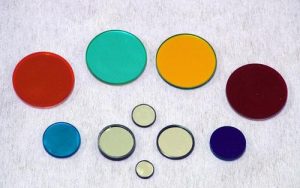There are many types of filters for tubes, but they all have the same basic function – transmitting light of a specific wavelength or color range while preventing the remaining wavelengths from passing through.
What are the different types of filters?
Optical filters are divided into two categories: absorption filters and dichroic filters (also known as interference filters).
Absorbent filters are often made of glass with selected organic or inorganic compounds added. These added compounds are used to absorb (essentially block) certain wavelengths while transmitting other wavelengths.
Dichromatic filters are almost the opposite of absorbent filters: they reflect selected wavelengths rather than absorb them, and then transmit the remaining wavelengths. Both types of optical filters have many functions, but dichroic filters can obtain most of the characteristics from optical coatings – based on the thickness and characteristics of the filter coating, they can reflect or transmit accurate wavelength ranges. This makes dichroic filters particularly effective in the scientific field. The camera also uses dichroic filters to separate light wavelengths based on film specifications.
In addition to absorbent and dichroic filters, there are several other filter types, including:
Monochromatic filter
A monochromatic filter transmits only one color (narrow wavelength).
Infrared filter
This type of endothermic filter transmits visible light but blocks the mid infrared spectrum. Incandescent bulbs depend on infrared filters.
uv filter
Ultraviolet filters effectively block the ultraviolet range of the spectrum, transmitting visible light like infrared filters. This type of filter is often used in cameras because film is sensitive to ultraviolet rays, while the human eye is not. In order to capture images on film with eye perception, all UV wavelengths must be filtered out.
Neutral density filter
A neutral density filter reduces the intensity of light at all wavelengths by filtering only a portion of each wavelength. The optical density of the filter, combined with certain logarithms, can accurately determine how much of each wavelength to block. This type of filter is useful in photography because it allows users to accurately capture images even in bright light. The neutral density filter can be absorbent or reflective.
Long wave pass filter
This type of filter is typically made of colored glass and can transmit longer wavelengths of spectrum, such as infrared, ultraviolet, and visible light. Long pass filters can block short wavelengths and are often used as emission filters in fluorescence microscopy, and are key components of dichroic (unidirectional) mirrors.
Short wave pass filter
Short wave pass filters serve the opposite function of long wave pass filters: they emit short wavelengths rather than long ones. They are colored glass filters that can only be used for the same application with opposite results and effects as long pass filters.
Bandpass filter
When a long pass filter and a short pass filter are combined, the resulting device is a bandpass filter. Although bandpass filters transmit less light than short and long pass filters, the number of layers in the filter can be controlled to transmit a wide or narrow range of light.
polarizing filter
Polarization filters block or transmit light based on the polarization of the filter. Reflections (such as water or shiny surfaces) have a high polarity – polarizing filters (such as those used in sunglasses and some camera lenses) can block certain reflective spectra, resulting in better visibility. Polarization filters can darken bright components in color photography, such as the sky, because of the high intensity of ultraviolet rays in the sky. They can also help manage reflections by minimizing the appearance in the final image.




